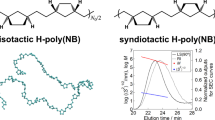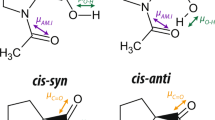Abstract
Spectral Investigations of certain polyfunctional phenolic compounds and of derivatives of the bile acids, using infra-red, ultra-violet and nuclear magnetic resonance techniques, reveal abnormally persistent intermolecular self-association through multiple hydrogen bonding. The extent of the effect, as measured by osmometry, depends on the stereochemistry of the molecules involved, especially the position and number of attached hydroxyl groups.
This is a preview of subscription content, access via your institution
Access options
Subscribe to this journal
Receive 51 print issues and online access
$199.00 per year
only $3.90 per issue
Buy this article
- Purchase on Springer Link
- Instant access to full article PDF
Prices may be subject to local taxes which are calculated during checkout
Similar content being viewed by others
References
Nakanishi, K., Infrared Absorption Spectroscopy: Practical (Holden-Day, Inc., San Francisco, 1964).
Tichy, M., in Adv. Org. Chem., 5, 115 (Interscience, New York, 1965). West, R., Korst, I. J., and Johnson, W. S., J. Org. Chem., 25, 1976 (1960).
Henbest, H. B., Meakins, G. D., and Wrigley, T. I., J. Chem. Soc., 2633 (1958).
Baker, A. J., Eglinton, G., Gonzalez, A. G., Hamilton, R. J., and Raphael, R. A., J. Chem. Soc., 4705 (1962).
Pitha, J., Joska, J., and Fajkos, J., Coll. Czech. Chem. Commun., 28, 2611 (1963).
Cairns, T., Eglinton, G., Scott, A. I., and Young, D. W., J. Chem. Soc., B, 654 (1966).
Anet, F. A. L., and Muchowski, J. M., Proc. Chem. Soc., 219 (1962).
Brown, I., Eglinton, G., and Martin-Smith, M., J. Chem. Soc., 2551 (1963).
Page, J. E., and Robertson, F. A., J. Chem. Soc., 133 (1943).
Datta, N. P., J. Ind. Chem. Soc., 16, 573 (1939).
Bellamy, L. J., Lake, R. F., and Pace, R. J., Spectrochim. Acta, 19, 443 (1963).
Cairns, T., and Eglinton, G., Nature, 196, 535 (1963); J. Chem. Soc., 5906 (1965).
Norman, A., Acta Chem. Scand., 14, 1295 (1960).
Nyström, E., and Sjoväll, J., Anal. Biochem., 12, 235 (1965). Also chapters by Sjoväll in Methods of Biochemical Analysis (edit. by Glick, D.) (Wiley, New York, 1964) and New Biochemical Separations (edit. by Morris, L. G., and James, A. T.) (Van Nostrand, 1964).
Kempter, H., and Mecke, R., Z. Physik. Chem., B, 46, 229 (1940).
Hagan, M., Clathrate Inclusion Compounds, 15 (Rheinhold Publishing Corp., New York, 1962). Bhatnagar, V. M., Chemical Age of India, 15, 827 (1964).
Wieland, H., and Sorge, H., Z. Physiol. Chem., 97, 1 (1916).
Go, Y., and Kratky, O., Z. Physik. Chem., B, 26, 439 (1934).
Kratky, O., and Giacomello, G., Monatsh, 69, 427 (1936).
Angyal, S. J., and Young, R. J., J. Amer. Chem. Soc., 81, 5251 (1959).
Author information
Authors and Affiliations
Rights and permissions
About this article
Cite this article
BENNET, W., EGLINTON, G. & KOVAC, S. Self-association of Phenolics and of Bile Acid Derivatives. Nature 214, 776–780 (1967). https://doi.org/10.1038/214776a0
Issue Date:
DOI: https://doi.org/10.1038/214776a0
This article is cited by
-
A classification of biologic lipids based upon their interaction in aqueous systems
Journal of the American Oil Chemists' Society (1968)
Comments
By submitting a comment you agree to abide by our Terms and Community Guidelines. If you find something abusive or that does not comply with our terms or guidelines please flag it as inappropriate.



